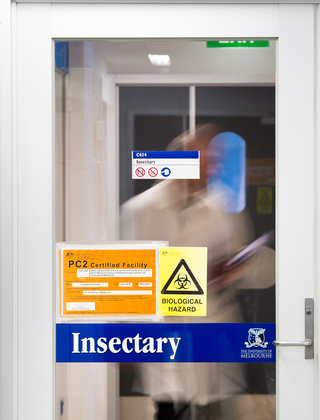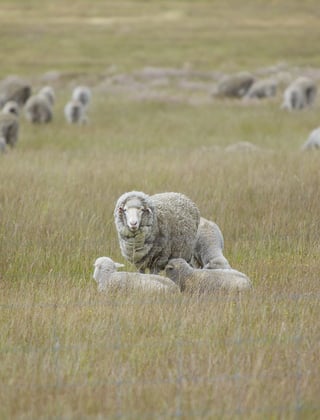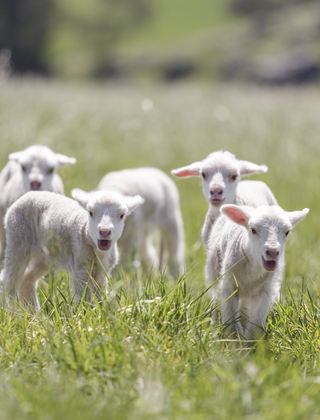Sheep flystrike risk factors
From 2005 to 2014 the ‘Breeding for Breech Strike Resistance’ project investigated the risk factors that increased the incidence of flystrike in Merinos at two sites, a high summer rainfall high altitude site at Armidale NSW (CSIRO) and a winter rainfall Mediterranean site at Mt Barker WA (DPIRD WA).
KEY POINTS
To reduce the risk of flystrike on a property:
-
Select for lower breech wrinkle, lower dags and cull for high urine stain. Aim for all sheep to be phenotypically score 2 or lower for the important traits for the property.
-
Once wrinkle, dags and urine stain are low, select for lower breech cover. Aim for all sheep to be phenotypically score 3 or lower.
-
Select for polled animals.
From 2005 to 2014 the ‘Breeding for Breech Strike Resistance’ project investigated the risk factors that increased the incidence of flystrike in Merinos at two sites, a high summer rainfall high altitude site at Armidale NSW (CSIRO) and a winter rainfall Mediterranean site at Mt Barker WA (DPIRD WA).
The sheep in the project were provided normal husbandry practices relevant to the region except for the fact that they were not given any preventative chemical treatments, nor for most years were they mulesed.
The data from these flocks were used to create new Australian Sheep Breeding Values for Breech Wrinkle, Cover and Dags, first released in late 2009. Progressively breeders have increased the collection of breech trait and pedigree data and selected for increased productivity with improvements in these welfare traits.
Flystrike risk factors are outlined below.
DAGS - Risk of breech strike exponentially increases with increasing dags

The site at Armidale had a low incidence of dags, (60% score 1 and 30% score 2) but for sheep that did express dags (mostly in the odd year when dags were higher than normal), the risk of breech strike was high. 50% of the score 3s, 80% of the score 4s and 140% of the score 5s got breech strike each year. A reasonable number of score 5s were struck several times per year. However, due to the low incidence of dags at the site, most strike was caused by other factors (wrinkle).
The site at Mt Barker had a high incidence of dags in most years and a similar risk of breech strike to the Armidale site across the dag scores from 1 to 5. The analysis proved that dags were a high risk factor for breech strike (along with wrinkle).
URINE STAIN - Risk of breech strike exponentially increases with increasing urine stain

The site at Armidale had a low incidence of urine stain, (60% score 1 and 30% score 2) but for sheep that did express stain, the risk of breech strike was high. 45% of the score 3s, and 130% of the score 4s were struck each year. Due to the low incidence of urine stain at the site, most strike was caused by other factors.
The site at Mt Barker had a high incidence of dags in most years and a similar risk of breech strike to the Armidale site across the dag scores from 1 to 5. The analysis proved that dags were a high risk factor for breech strike (along with wrinkle).
BREECH WRINKLE - Risk of breech strike increases exponentially with increasing breech wrinkle

The site at Armidale had a high level of breech wrinkle, (60% were score 3 and higher) and they had a high risk of getting breech flystrike. 20% of the score 3s, 35% of the score 4s and 70% of the scores 5s got breech strike each year. Most breech strike was caused by wrinkle and most strike started on the breech rather than the tail. (Note: after 10 years of 'single trait' selection for flystrike, the Resistant Sires average Wrinkle ASBV was -0.6; the Susceptible Sires averaged +0.6).
The site at Mount Barker had a lower level of breech wrinkle (most were score 1 and 2) but a similar risk of breech strike across the wrinkle scores from 1 to 5 to the Armidale site. Dags and wrinkle were the main cause of breech strike. When breech strike occurred most started on the tail rather than the breech.
BREECH COVER - Risk of breech strike increases with increasing breech cover
The site at Armidale had a high level of breech cover (80% were score 4 and higher) but a lesser risk of getting breech flystrike. 10% of the score 3s, 20% of the score 4s and 30% of the scores 5s got breech strike.
The site at Mount Barker had a low incidence of breech cover but a similar risk of breech strike. Due to the low level of breech cover, most strike was caused by other factors (dags and wrinkle).
HORNS - Risk of poll strike increases with horned rams
The site at Mount Barker had a low level of poll strike in the true polled rams (less than 5%) and higher incidence of poll strike in fully horned (30%).
The Site at Armidale was dominated by horned genetics, and most were horned rams.
According to the AWI 2017 Husbandry Practices Survey, polled Merinos now account for two thirds of the total Merino numbers. Polled Merinos are most popular in SA (90%) and WA (74%) and least popular in Tasmania (43%) and Queensland (46%). Both NSW and Victoria have 58% polls.
ASBV PERCENTILE TABLE FOR 2018 DROP ALL MERINO BREED SHEEP IN MERINOSELECT

TARGET AUSTRALIAN SHEEP BREEDING VALUES
There is considerable variability between wool-growing regions and properties in the degree to which wrinkle, worms and dags are actually ‘phenotypically’ expressed.
Around 50% of Merinos reside in ‘low dag’ country, where dags are not or very infrequently expressed. Dags are only a factor if surplus sheep are sold into high dag regions. The same applies to worms, if in low worm country there is little need to select for worm resistance.
Breeding for lower dags and lower wrinkle combined will take considerable time.
Currently the top 10% of animals for dags have a breeding value of -0.3 or less, the top 1% of animals are -0.4 or less.
The actual or ‘phenotypic’ expression of wrinkle is also dependent on a range of factors, such as nutrition as a foetus and a lamb, along with impacts such as cold conditions and worms. Even on a property, wrinkle is expressed in the lamb drop more in good seasons and less in drought.
Some high profile non mulesed ram breeders have low fly risk with breeding values for wrinkle at -0.3, other non mulesed ram breeders in high wrinkle country need to average -0.8 to -1.0. The top 10% of MERINOSELECT animals are -0.8 or less.
The base year for the three breech traits is 2000, the base year for most other traits is 1990. Since 2000 the average wrinkle score has fallen to -0.2, cover to -0.1 and dags to -0.1.
Within the Merino types, medium Merinos' average wrinkle ASBV is -0.5, fines average -0.2 and superfines average +0.1.
Woolgrowers frequently ask can we breed a new type of Merino that has low scores for the breech traits and worms that are also high in productivity (fleece value and number of lambs weaned)? This, and the current availability of these type of sires with MERINOSELECT data, will be addressed in the June edition of Beyond the Bale.
MORE INFORMATION
- Sheep Genetics MERINOSELECT Web Search http://sgsearch.sheepgenetics.org.au/?dataset=5
This article appeared in the March 2020 edition of AWI’s Beyond the Bale magazine. Reproduction of the article is encouraged, however prior permission must be obtained from the Editor.















